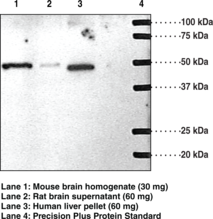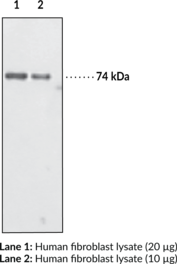Description
Sphingosine-1-phosphate (S1P) exerts its activity by binding to five distinct G-protein-coupled receptors, S1P1/EDG-1, S1P2/EDG-5, S1P3/EDG-3, S1P4/EDG-6, and S1P5/EDG-8.{11895,12477} S1P1 primarily couples with pertussis toxin-sensitive Gi/o proteins to mediate S1P-induced cell proliferation, survival, migration, cytoskeletal organization, and morphogenesis.{11895,12477,10628} Expression of S1P1 is abundant in embryological vasculature and is ubiquitously expressed in adult cells suggesting diverse physiological functions of this receptor.{12477} The human and mouse S1P1 receptors have 382 amino acids with an estimated molecular weight of 43 kDa. Glycosylation at the N-terminal extracellular domain may cause the protein to migrate at a higher position in SDS-PAGE.{12476} Cayman’s S1P1 Polyclonal Antibody detects the receptor at 47 kDa by WB analysis. The antibody can also be used for IF and IHC to study expression patterns of this protein.
Synonyms: EDG-1|S1PR1|Sphingosine-1-phosphate Receptor 1
Immunogen: Peptide from an internal cytoplasmic region of human S1P1
Formulation: 500 µl of peptide affinity-purified IgG
Isotype:
Applications: IF, IHC, and WB
Origin: Animal/Rabbit
Stability: 365 days
Application|Immunofluorescence||Application|Immunohistochemistry||Application|Western Blot||Product Type|Antibodies|Polyclonal Antibodies||Research Area



